 Born and bred in Inverness, with a zoology degree from Aberdeen, I managed the reintroduction of Sea Eagles from Norway to Rum 1975 to 1985, for NCC, and remain on the UK Project Team as an independent. Moved to South Uist as Area Officer for SNH/NatureScot covering Uist, Barra and St Kilda 1992-2006. Retired to lecture on small cruise ships around the world until present and written several books including ‘The Return of the Sea Eagle‘ ( 1983) and ‘A Saga of Sea Eagles’ (2013). Still living on South Uist.
Born and bred in Inverness, with a zoology degree from Aberdeen, I managed the reintroduction of Sea Eagles from Norway to Rum 1975 to 1985, for NCC, and remain on the UK Project Team as an independent. Moved to South Uist as Area Officer for SNH/NatureScot covering Uist, Barra and St Kilda 1992-2006. Retired to lecture on small cruise ships around the world until present and written several books including ‘The Return of the Sea Eagle‘ ( 1983) and ‘A Saga of Sea Eagles’ (2013). Still living on South Uist.
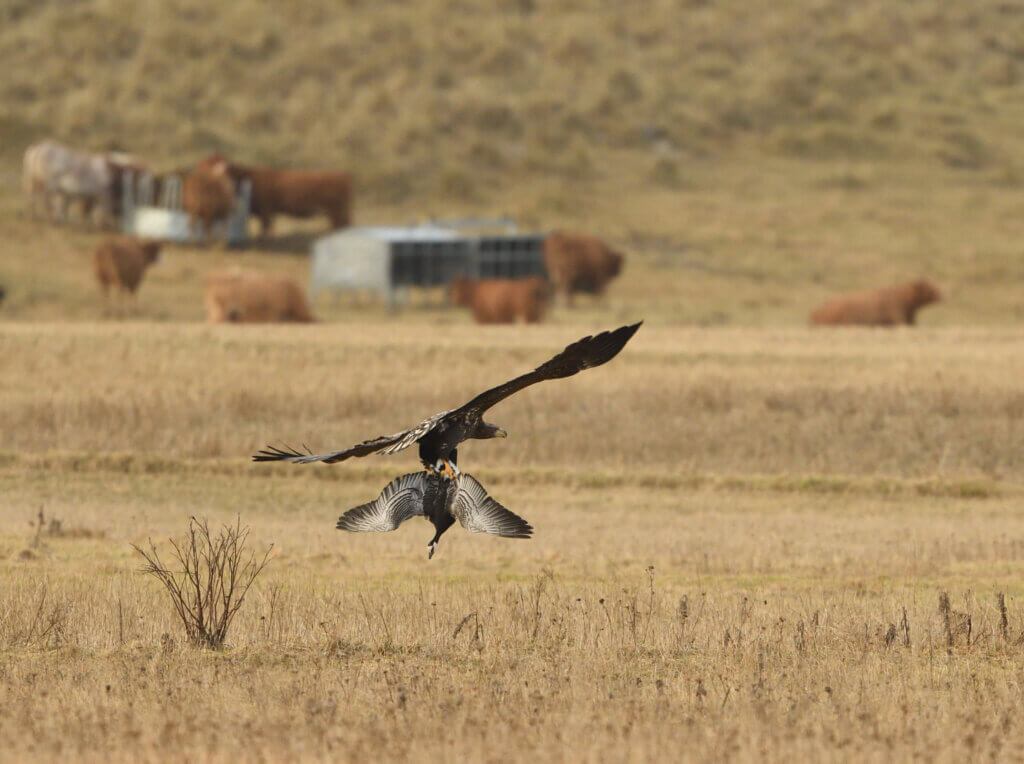
The White-tailed Sea Eagle seems always to receive a bad press these days, especially during lambing time. It has never been denied that some eagles have killed young lambs – but we now know that this tends to be a local issue and in truth, despite all the media hype, it is quite rare. Furthermore, recent research has now shown that this is happening even less nowadays than in the earliest days of the reintroduction. It must be accepted that if a Sea Eagle is seen eating at a lamb or sheep carcase it does not mean the eagle had killed it. And indeed, Sea Eagles have never been known to have killed an adult sheep (nor cows which some have tried to claim!)
Although shepherds do not like to admit it, sheep still die out on the hill from a variety of causes. A study by Dr David Houston, of crow predation in Argyll in the 1970s found that some 15-20% of lambs died, mostly in the first week of life. 254 lamb carcases were brought in by shepherds: 27% were still born, 9% were diseased, 5% had been accidentally killed (crushed by ewe, strangled in fences, hit by cars, killed by dogs), 45% of them had exhausted fat levels and only 7% seemed perfectly healthy. Perhaps this level of mortality no longer prevails today and there is currently a study underway to examine such ‘black losses’ amongst lambs.
Adult sheep in poor condition can be attacked and killed by foxes, dogs or by gulls, Ravens or crows. Sea Eagles never peck the eyes out, a clue to who really had been the culprit. Although a bird of prey (and therefore equipped to kill) the White-tailed Sea Eagle is more related to vultures – in habits as well as lineage. Indeed, being more akin to vultures than they are even to Golden Eagles it is not surprising that Sea Eagles should be especially fond of carrion. This was recognised by Robert Gray In his ‘The Birds of the West of Scotland’ where in 1871 he wrote’: ‘The chief food of [the Sea Eagle] appears to be stranded fish, procured in the vicinity of its maritime haunts, dead sheep found on the moors, and occasionally a salmon left by some scared otter – a selection more in keeping with the innocent life of a vulture than the plundering habits usually ascribed to eagles.’
I have scrutinised a lot of old books, collectors’ notebooks etc from those early days. They are important because they were written by people with first-hand experience, at a time when there were still native Sea Eagles around. Professor William MacGillivray, brought up in Northton, Harris confirmed in 1886 how ‘at seasons of mortality among sheep, as in the end of autumn, when braxy commits its ravages, or at the end of spring, when severe weather often causes the death of young lambs, [Sea Eagles] are not uncommonly seen hovering about’.
Let us not forget that in the nineteenth century, during the Highland Clearances, many people were being cleared from their homelands to make way for more sheep. Grasping landlords replaced their tenants with huge flocks of Blackface and Cheviots. The island of Rum, where I once lived and about whose human history I have written a book, was one case in point – and it was by no means unusual. In 1826 and 1828 over four hundred islanders were shipped off to Canada, to be replaced by no fewer than 8000 Blackface sheep. Not surprisingly this wet, unforgiving and rocky island was quickly overgrazed and soon could not possibly support such numbers. The sheep walk never did make the expected profit, and the flock further dwindled. Rum became a sporting estate until, in 1956 the sheep were all gone, and the island was sold as a nature reserve.
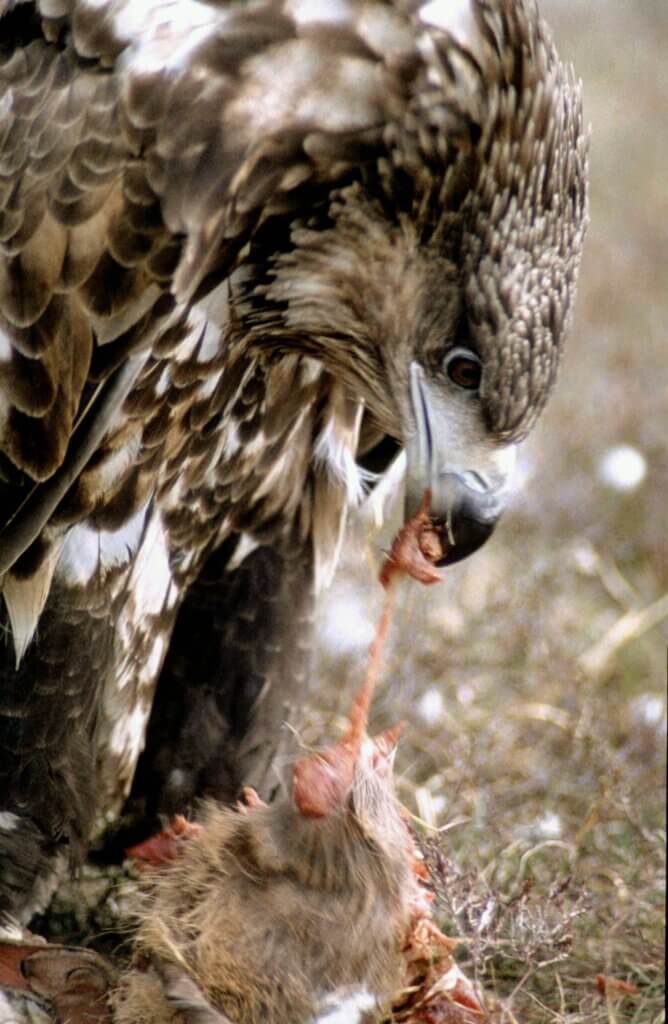
This state of affairs was common throughout the Highlands and Islands so, given the Sea Eagles’ taste for carrion, we have to ask was its total extermination in the UK by 1916 really justified? The species was widespread here before humans appeared on the scene. It was the Sea Eagles’ very fondness for carrion that was proving its undoing. It was accused of taking lambs, so poison baits were hugely destructive, later alongside shooting and egg collecting.
It seems only right, in these enlightened times, that this magnificent bird should be back where it belongs. As part of a third reintroduction attempt, in 1975 (bringing birds across from Norway and to be released on the Isle of Rum nature reserve) I looked in detail at the history of Sea Eagles in Britain. Most of the old literature confirmed the Sea Eagle’s love of carrion (hence its fatal vulnerability to poisoning) but I was surprised to find such accounts had less to say about the bird’s impact on lambs. Several communities even went as far as to make the exact opposite claims – that their local Sea Eagles never touched lambs. St Kilda, South Uist, the Shiant Isles and Fitful Head in Shetland were examples. I noted 141 prey items that had been found in Sea Eagle eyries by egg collectors etc. Only 12 (9%) involved lambs; and 7 of these were from a single nest in the Lake District. It is often difficult to tell whether lamb remains found in nests had been killed or found already dead. Certainly back then, with high losses amongst sheep flocks for a host of reasons, there had been no shortage of carrion for Sea Eagles. And we now know that large, conspicuous items such as sheep, lambs and deer, always tend to be over-represented at nests, compared with fish and small creatures whose bones could be ingested and – if not digested completely – were regurgitated later in pellets elsewhere.
I also found a further 46 observations of Sea Eagles feeding away from the nest, mostly in winter. But the old literature would imply that Sea Eagles were never as responsible for killing lambs as history later came to assert. Thus, it seems that nowadays some arch-critics of the Sea Eagles’ comeback are re-inventing the mistakes of the past. Sea Eagles are lazy hunters so readily find carrion as an easier meal. But still, it is being assumed that eagles seen feeding on dead sheep or lambs are assumed to have killed them. Sure, Sea Eagles can kill small lambs but, at the end of the day, just how many shepherds have actually seen it happen and are not merely making false assumptions based on others’ claims?
One study had taken place back in 2010 to investigate alleged lamb losses in the Gairloch area. It was here that, in 1900, Charles Dixon observed: ‘[the Sea Eagle] is a regular scavenger of the shore . . . Healthy vigorous birds or animals are seldom attacked by this eagle: it confines its attentions to the weakly and the wounded creatures that cannot move fast or offer any serious resistance.’ But in fact, the 2010 study found no lambs lost to eagles that season (however the complainants went on to counter that it was because there were too many researchers around!) Mull was regularly appearing as a major problem area for lamb kills in the early days, and it is here that some of the best studies have been undertaken ( by Mick Marquiss and colleagues). One nest in Mull did present a worst-case scenario, but only in one year over several studied. Of the 45 lamb remains taken by this pair in 1999, 21 were intact enough to show the cause of death and revealed that only 13 (or 62%) had been taken alive. Even then, this suggested that this pair might well have killed a total of 30 all season. Rabbits had been scarce that year due to an earlier myxomatosis outbreak. In the year 2000 this pair moved to another nest nearer the coast where fewer lambs were available and Rabbit numbers had recovered. That year, of 19 lambs examined in this nest only four (21%) showed signs of predation.
In 1999 it was found that a second pair had scavenged all but one of the 11 lambs examined; no data was available the following year since their breeding attempt failed. A third Mull pair investigated that year took hardly any lambs despite having to fly over lambing areas to catch seabirds on the coast 15 km distant. In 2001, at a nest in Skye with the highest total of lambs found, all had been scavenged and none had been killed. Local crofters there might dispute these results. But it is clear, from good science, that incidences of eagles killing lambs is very much a localised problem and not even an annual one. When, a decade ago, the study had been widened to include data from all the other Mull nests the annual consumption of lambs, was in the order of 200, and most of them would have been scavenged rather than killed.
It was estimated that Mull supported over 20,000 breeding ewes in total but the research had confirmed that numbers of lambs taken varied between Sea Eagle pairs, and from year to year, while some pairs never looked at lambs. Furthermore, the losses attributable to eagles were small compared with other sources of mortality. Losses had minimal impact on the sheep economy of the island as a whole – though perhaps not on those few unfortunate crofters with an odd rogue pair of eagles.
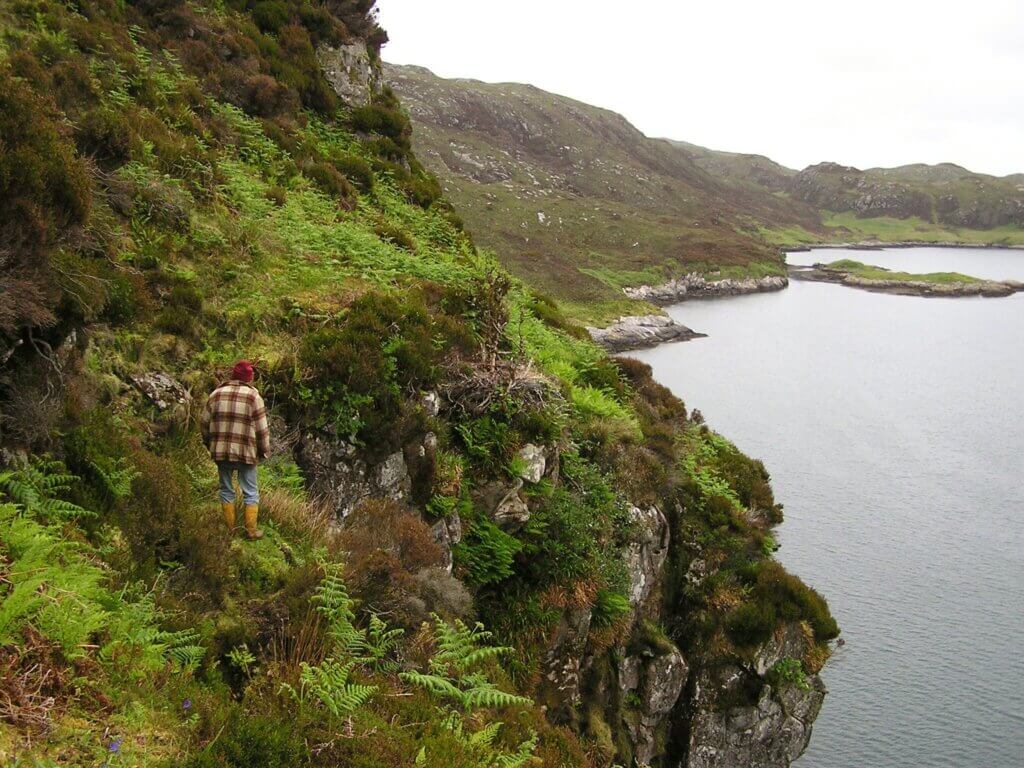
A study has now just been completed over several years, examining over 11,000 prey items recovered after the Sea Eagles’ breeding season, from no fewer than 92 different eyries. We now know more about the diet of Sea Eagles than most other birds of prey in this world. White-tailed Sea Eagles have been known to take several hundred different prey species, alive or dead. Seabirds, fish with Rabbits constitute the main diet of Scottish Sea Eagles. They also hunt and kill other predators of lambs – gulls, crows, Ravens even the odd fox. Currently we have some 130 to 150 pairs of Sea Eagles now breeding in Scotland and Ireland. Norway on the other hand (where our original reintroduced eaglets came from) protects its Sea Eagles and now has 3000-4000 breeding pairs; rarely, if ever, do Norwegian sheep farmers experience any Sea Eagle predation on livestock. And we can’t seem to live with only 150 pairs!
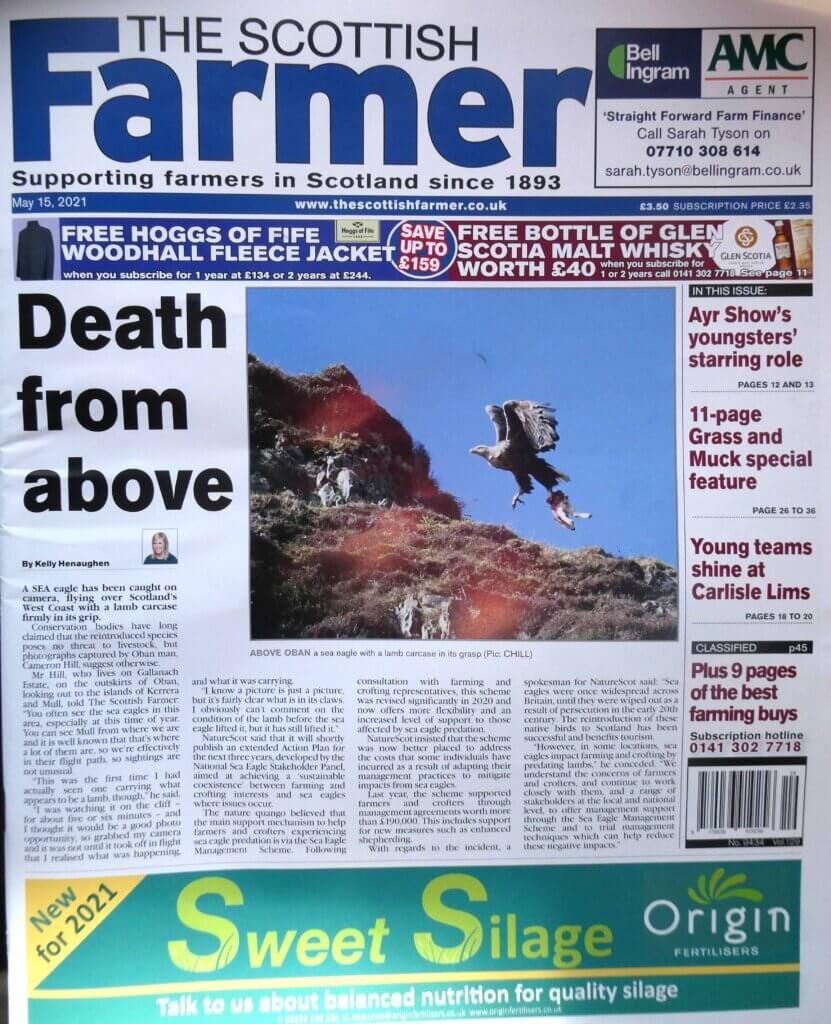
I can only conclude from the eye-witness accounts from a time that Sea Eagles still existed, how the Sea Eagle’s extermination had been unjustified – and seems based on circumstantial evidence only or on hearsay. Now we seem to be repeating this error, jumping to conclusions again, fuelled by a few outspoken but perhaps influential critics, by misinformed politicians seeking votes, officials wanting to avoid confrontation, not helped by the media who thrive on such confrontation. But I would ask that, to avoid reinventing the mistakes of the past, we keep a proper perspective on the eagle issue, listen to the science and remember that the unfortunate decline of the sheep industry is due to a whole host of other reasons not at all connected with predation.
There was danger in introducing management payments – which sheep farmers still see as compensation for their alleged lamb losses. The money will never be enough so the problem is further exaggerated. Need we be apologising for bringing this magnificent creature back to where it should still belong? The Sea Eagles are merely providing a convenient, high-profile scapegoat (no need to blame Golden Eagles nowadays). Critics totally ignore the huge benefits the reintroduced Sea Eagles are bringing on a much wider scale. Ten years ago, a study of rural communities where Sea Eagles are to be found, revealed just how much commercial benefit they are bringing through tourism, in the way of visitors, bird watchers and other tourists, local safaris, boat trips, public viewing, even bums in bed and breakfasts, guest houses and hotels. In Mull alone the island economy was benefitting by up to 5 million pounds a year! A fresh study, just recently published, came to even more encouraging and more lucrative conclusions.
Living in South Uist as I do, we are finding that, on top of not dissimilar economic benefits, our resident Sea Eagles are also preying upon other pest species like Rabbits, gulls and crows, but they are also killing more and more Greylag Geese – which are an increasing problem for crofters. We have umpteen photos and videos of this happening but, with most crofters carrying a mobile phone these days, I have yet to see photographic evidence of eagles actually killing lambs. Even the eagles’ presence in an area can deter geese from damaging growing crops, as some crofters have experienced. Exactly the same is now being found elsewhere, such as Islay, Jura, Mull, also Lochaber and mainland Argyll. I, for one, fully appreciate the benefits crofting brings to conservation, to rural communities, local economies, even the Gaelic language and culture, but sheep are only part of the story and should not come at the expense of all these other proven benefits. Geese may not be laying golden eggs these days but Sea Eagles most definitely are!
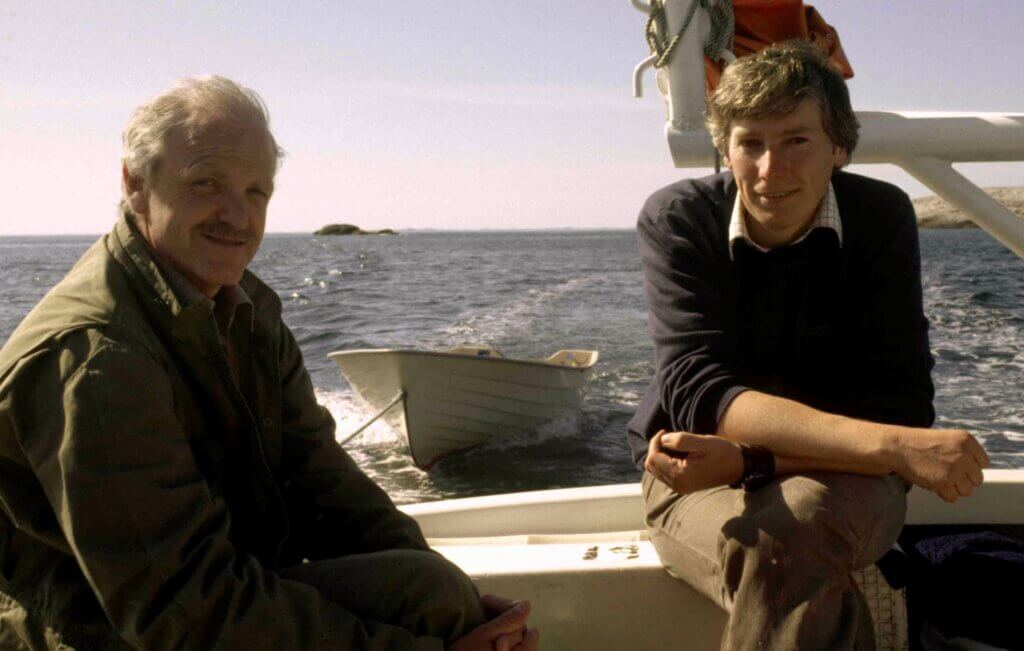
Thanks John
Very informative blog.
What about pigs and piglets? Are they prey?
That seemed to be a consideration when a reintroduction project was scrapped a couple of years ago.
NO, not at all. The only reference of which I am aware was a captive sea eagle in the Outer Hebrides which was afraid of pigs! Farmers will claim anything against predators in the hope of extracting more money and so the Chinese whispers continue. These are management payments not compensation – meant to improve stock husbandry, not to compensate for every lamb death they allege was due to sea eagles. Nobody complains about golden eagles these days because there is no money in them. I was told once that when the Railways were paying compensation to farmers for cattle killed by trains, every dead cow was dragged to the nearest railway line! We should never have begun offering any sort of payment (except in very rare, well verified local cases) and start apologising for bringing this wonderful creature to where it truly belongs, before it was cruelly (and wrongly) exterminated.
A lovely update of the renascence of the Sea Eagle in Scotland. The Sea Eagle can now be seen flying over the Solent and the Isle of Wight which can be directly attributed back to the successful reintroduction programme on the Isle of Rum in the 1970s. Though reintroductions alone cannot be the answer and along side them we need to have the willingness and funding to encourage learning in the host communities so that even more people can gain the benefits of nature.
Thanks for a brilliant blog John and tackling an issue too many shy away from – being even slightly critical of the claims being made by parts of the farming community. The whole situation re sheep mortality is rather strange. A friend of mine claims that way back in the 1970s the Norwegian government offered to build as a gift to the Scottish people a building used to help sheep survive winter more easily in a climate even colder than ours for demonstration purposes. For some bizarre reason this kind and generous offer was turned down. Why? Might the real point with sheep farming be the subsidy, good husbandry is not so important? Even in my part of Scotland there’s a bit of sheep farming and there are tales of sheep being temporarily ‘borrowed’ from other farms in advance of official visits to raise stock numbers for what I would imagine were headage payments at the time. I do believe that there’s a big, likely co-ordinated drive for compensation to access yet another income stream, some dodgy things go on including farmers injecting cattle with diesel to try to get fake TB results and the compensation that goes with that https://www.bbc.co.uk/news/uk-wales-46593004 There’s a tremendous reluctance to have open and honest discussion about farming and farmers which is not healthy and certainly won’t help decent farmers. So glad you brought up what happened at Gairloch, that’s something certain people will want forgotten so they can try that angle again.
Excellent article that makes a very powerful case for the Sea Eagle being both economically beneficial to the scottish economy AND no significant threat to the sheep farming industry. Sadly, we know that many of those who are hostile to birds of prey are also impervious to facts but it is important to keep publicising those facts to resist the tendency for falsehoods to otherwise become accepted as ‘self-evident truths’. The Scottish Farmer article depicted is a classic example of how easy it is for minimal information to be presented in a highly prejudicial way.
“Although shepherds do not like to admit it, sheep still die out on the hill from a variety of causes.”
Which is weird, because among themselves and farming kinfolk, sheep farmers (I refuse to call them shepherds, because shepherds spend the nights out with the flock and not sitting watching Sky Sports in their living rooms) will readily admit that there is no animal as champion at dying as the average sheep. Sheep were born to die, they’ll say, and the challenge is keeping them alive long enough to die at a profit. It is sheer hypocrisy on their part.
Great article John. I challenge the “Scottish Farmer” to reproduce it, but wont hold my breath!